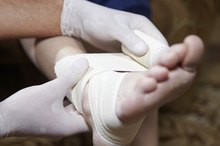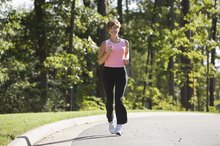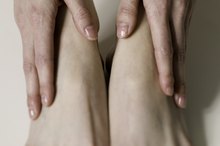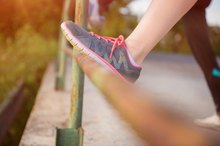What does fact checked mean?
At Healthfully, we strive to deliver objective content that is accurate and up-to-date. Our team periodically reviews articles in order to ensure content quality. The sources cited below consist of evidence from peer-reviewed journals, prominent medical organizations, academic associations, and government data.
- National Center for Biotechnology Information; Plantar Fasciitis; June 2010
- National Center for Biotechnology Information; Plantar Fasciitis; June 2010
The information contained on this site is for informational purposes only, and should not be used as a substitute for the advice of a professional health care provider. Please check with the appropriate physician regarding health questions and concerns. Although we strive to deliver accurate and up-to-date information, no guarantee to that effect is made.
Running and Bruising on the Sole of My Foot
Running-related bruising on the sole of the foot can be worrisome, especially if it is accompanied by other symptoms such as pain 1. It can be caused by a variety of conditions and training errors. As this bruising can sometimes require a doctor’s intervention, it is important to understand why bruising can occur on the soles of your feet after running and how it can be treated.
If you are experiencing serious medical symptoms, seek emergency treatment immediately.
Symptoms
Bruising on the sole of the foot after running can vary from mild to severe. Symptoms can worsen when you pull up on your toes or press on the ball of your foot. Bruising and pain can feel worse in the morning, fading into a dull ache by the end of the day or after a period of rest.
Causes
Foot Pain in the Heel From Playing Soccer
Learn More
Bruising can occur on the sole of your foot if you overuse the tendons, fascia and bones with excessive running, over striding or by not taking proper breaks as needed. It can also occur if you frequently run long distances, on uneven terrain, or wear worn or improper footwear. Bruising on the sole of the foot can also be caused by conditions such as plantar fasciitis, heel spurs and metatarsalgia.
Treatments
Cut back on your running speed, distance and intensity. Place an ice pack against the bottom of your foot for about 10 minutes at a time right after your running routine. Take an anti-inflammatory medication to help ease symptoms. Wear running shoes that are flexible and offer proper arch support. Place heel pads or makeup sponges into the heel of your shoe to help absorb shock and shift weight away from any painful areas. Wear a thick pair of cushioned socks or slippers when not running.
- Cut back on your running speed, distance and intensity.
- Place an ice pack against the bottom of your foot for about 10 minutes at a time right after your running routine.
Tips
How to Jog With Patellar Chondromalacia
Learn More
Extra body weight places pressure on the bottom of your feet: continue running and eating right in order to reach or maintain a healthy weight. If bruising is new, evaluate what types of conditions or factors -- such as increasing your training intensity or running on uneven terrain -- could have caused it. Consult a doctor or sports physician if symptoms are severe or do not improve with self care. An X-ray may be required to rule out a serious problem such as a fracture.
- Extra body weight places pressure on the bottom of your feet: continue running and eating right in order to reach or maintain a healthy weight.
- Consult a doctor or sports physician if symptoms are severe or do not improve with self care.
Related Articles
References
- Cool Running; Foot Pain; Josh Clark
- American Academy of Podiatric Sports Medicine; Articles and Resources; Phyllis A. Ragley
- Hofmann M, Young C, Binz TM, Baumgartner MR, Bauer N. Contact to nature benefits health: Mixed effectiveness of different mechanisms. Int J Environ Res Public Health. 2017;15(1). doi:10.3390/ijerph15010031
- Hespanhol Jr LC, Pillay JD, van Mechelen W, Verhagen E. Meta-analyses of the effects of habitual running on indices of health in physically inactive adults. Sports Med. 2015;45(10):1455–1468. doi:10.1007/s40279-015-0359-y
- Rector RS, Rogers R, Ruebel M, Widzer MO, Hinton PS. Lean body mass and weight-bearing activity in the prediction of bone mineral density in physically active men. J Strength Cond Res. 2009;23(2):427-35. doi:10.1519/JSC.0b013e31819420e1
- American Diabetes Association. Exercise and type 1 diabetes.
- Morton D, Callister R. Exercise-related transient abdominal pain (ETAP). Sports Med. 2015;45(1):23–35. doi:10.1007/s40279-014-0245-z
- Hamill J, Gruber AH. Is changing footstrike pattern beneficial to runners?. J Sport Health Sci. 2017;6(2):146–153. doi:10.1016/j.jshs.2017.02.004
- Kerksick CM, Arent S, Schoenfeld BJ, et al. International society of sports nutrition position stand: nutrient timing. J Int Soc Sports Nutr. 2017;14:33. doi:10.1186/s12970-017-0189-4
- American Heart Association. Strength and resistance training exercise.
Writer Bio
Rose Erickson has been a professional writer since 2010. She specializes in fitness, parenting, beauty, health, nutrition and saving money, and writes for several online publications including The Krazy Coupon Lady. She is also a novelist and a mother of three.









